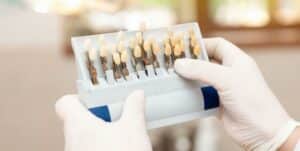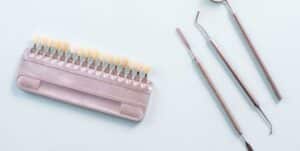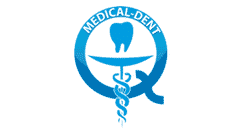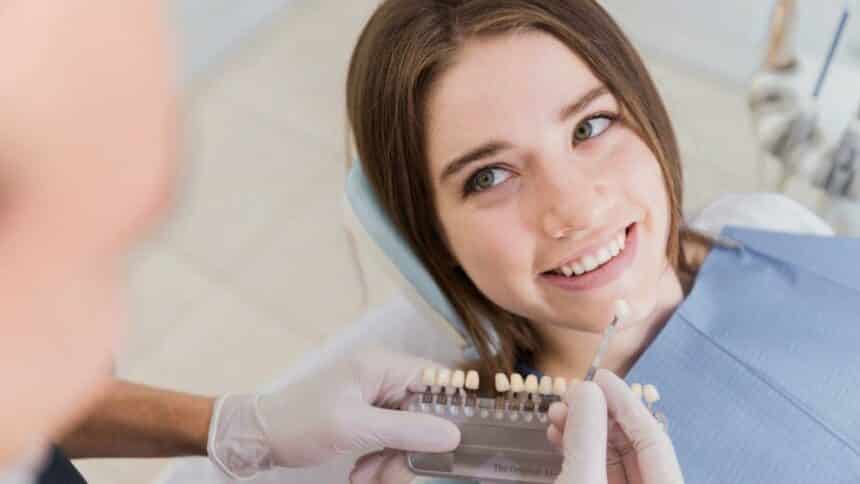White, yellow, orange, pink or even dark brown - changes in the colour of the teeth. They have different causes and different treatments. They have one thing in common, if you notice them it is best to make an appointment with your dentist as early as possible.
Causes of tooth colour change
The colour of your teeth depends primarily on good oral hygiene, but not only. Genes and the natural shade of your bones are also responsible for whether your teeth are snow-white or have a slightly yellowish tinge. We wrote more about this in our article "What tooth colour depends on", so if you are interested in this topic we invite you to read on.
For changes in tooth colour Also influenced by past illnesses and the use of certain medications. And, of course, your diet. Some products have colouring substances in them which, by adhering to the tooth, can change its colour.

From white to brown
Changes in the colour of your teeth can occur over a wide range of shades - from chalky white to black. Whatever their cause, as soon as you notice them it is worth making an appointment to see your dentist. Early diagnosis allows early treatment and thus minimises the risk of discolouration of subsequent teeth.
We will discuss the most common tooth colour changes below.
White spots on teeth
White, opaque discolouration of teeth can result from trauma suffered during the period of enamel formation, primary caries or demineralisation of the enamel.
Such changes usually appear on one or more teeth. If there are more white, dull spots it may indicate a malformation of the enamel - amelogenesis imperfecta. They can also signal health problems - hypothyroidism or hyperthyroidism and problems with the thymus gland. We wrote more about diseases that affect the condition of the teeth in our article "Drugs and diseases that spoil teeth"
Yellow changes in tooth colour
Yellow discolouration of teeth usually occurs on one or more teeth and may be due to genetic abnormalities in enamel development. Another cause may also be progressive demineralisation of the enamel of a carious nature.
As with white spots, yellow changes in the colour of the teeth can also be the result of diet. And if they occur on more teeth, conditions causing hyperbilirubinaemia, bullous epidermal separation (epidermolysis bullosa) or moderate fluorosis may be the cause.

Orange and pink teeth
The cause of orange discolouration of teeth is most often due to external factors, caused by the activity of chromogenic bacteria. Substances used in endodontic treatment, such as Grossman's cement, zinc oxide with eugenol, endometasone, are also responsible.
In contrast, pale pink discolouration are the result of the use of preparations such as Tubli-Seal or Diaket as sealers in endodontics. Pinkish lesions are also observed in congenital porphyria.
Brown changes in tooth colour
Brownish discolouration of teeth is quite common. They can result from diet or from drinking too many drinks containing pigments, such as coffee, tea and cola. Brownish changes in the colour of the teeth are also influenced by smoking and marijuana.
They are also a side effect of plaque build-up. This also has its other serious consequences in terms of the risk of periodontitis. We wrote more about it in our article "Modern periodontitis treatment in the UK with Vector Paro Pro". Therefore, remember to have good oral hygiene, but also regular visits to the dentist for hygienization.
It is not only external factors that affect brown changes in the colour of teeth. They can also be a sign of pulp injury or caries.
What next?
As we have already mentioned, if you have noticed any changes in the colour of your teeth, it is best to make an appointment with your dentist as soon as possible.
During the visit, the dentist will not only recommend the correct treatmentbut will also select the right toothpaste and toothbrush for you and give you all the information you need on how to prevent discolouration on your teeth in the future.
And if you have any further questions - please feel free to contact.

